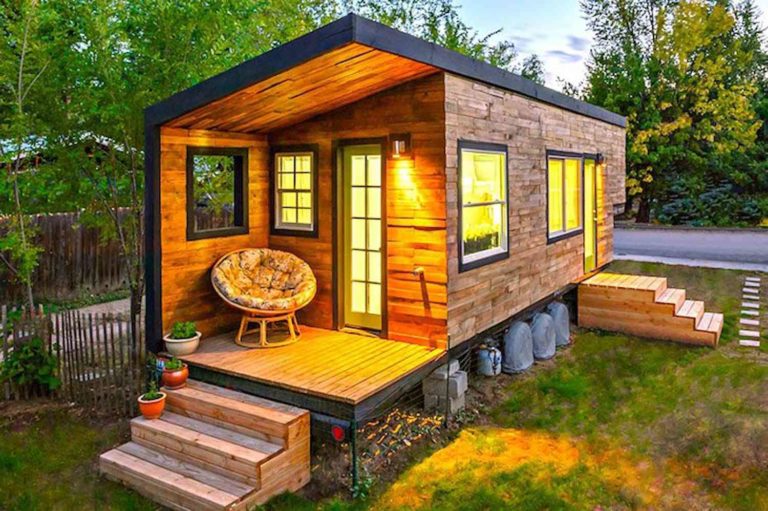Building a tiny home can be an exciting but budget-straining endeavor.
However, with a little bit of creativity and resourcefulness, you can save money without sacrificing quality or functionality.
From repurposing materials to incorporating energy-efficient features, there are plenty of ways to cut costs without compromising on your dream home.
We’ll explore some innovative methods for saving money on your tiny home build.
Use reclaimed or recycled materials
Consider using materials that would otherwise be thrown away, such as reclaimed wood, recycled metal, or repurposed furniture. Not only will this save you money, but it will also help reduce waste and support sustainability.
Consider incorporating materials like reclaimed wood, recycled metal, or repurposed furniture into your design.
Not only will this help you save money, but it will also support sustainability by reducing waste and conserving natural resources.
One way to incorporate reclaimed materials into your design is by using reclaimed wood.
This can include materials like reclaimed barn wood, reclaimed fir, or reclaimed pine.
These materials can add warmth and character to your space while also being budget-friendly.
Another option is to use recycled metal, such as recycled steel or aluminum, which can be used for everything from light fixtures to hardware.
Repurposed furniture is another great option for those looking to incorporate reclaimed materials into their design.
Consider refinishing or repurposing old furniture pieces to give them new life.
This can be a great way to add unique pieces to your space while also supporting sustainability.
By choosing to use reclaimed or recycled materials, you can create a beautiful and environmentally conscious space that reflects your personal style.
DIY as much as possible
If you have the skills and time, consider doing as much of the build as you can yourself. This will save you money on labor costs and give you a sense of accomplishment and pride in your home.
If you have the skills and time, consider doing as much of the build as you can yourself.
Not only will this save you money on labor costs, but it will also give you a sense of accomplishment and pride in your home.
By tackling DIY projects, you’ll be able to customize your home to your exact specifications and preferences.
The DIY approach will allow you to learn new skills and gain valuable experience, which can be a rewarding and fulfilling experience.
Not only will DIYing help you save money, but it will also enable you to have more control over the build process.
You’ll be able to choose the materials and techniques that best suit your needs and preferences, and you’ll be able to ensure that every aspect of your home is built to your exact specifications.
Plus, the sense of accomplishment and pride that comes with DIYing your home can be incredibly fulfilling, and will make you feel more connected to your home and the building process.
Overall, DIYing as much of your build as possible is a great way to save money, gain new skills, and have more control over the build process.
So, if you have the skills and time, consider tackling as many DIY projects as you can to make your home building process an even more rewarding experience.
Build a tiny home on wheels
Building a tiny home on wheels can be a cost-effective option, as it allows you to avoid foundation costs and other permits required for traditional foundation building.
Building a tiny home on wheels can be a cost-effective option for those looking to downsize or simplify their living situation.
By avoiding the need for a traditional foundation, you can save money on construction costs and skip the permits and inspections required for a fixed-foundation home.
Building on wheels allows for greater flexibility and mobility, as your home can be easily moved to a different location if needed.
This can be particularly appealing to those who enjoy traveling or who need to adapt to changing living situations.
Plus, tiny homes on wheels are often more energy efficient and environmentally friendly than larger, traditional homes.
Overall, building a tiny home on wheels offers a unique combination of cost-effectiveness, flexibility, and sustainability, making it an attractive option for those looking for an alternative to traditional homeownership.
Opt for a prefabricated tiny home
Pre-fabricated tiny homes can be a more affordable option than building a home from scratch. Look for options that are well-designed, sturdy, and come with good warranties.
Choosing a prefabricated tiny home can be a cost-effective and practical solution for those looking to own a compact living space.
Prefabricated tiny homes are designed and constructed in a factory, allowing for a more efficient and controlled build process.
This can result in significant cost savings compared to traditional on-site construction methods.
Prefabricated tiny homes are often well-designed and sturdy, featuring high-quality materials and attention to detail.
Many manufacturers offer good warranties on their products, providing peace of mind and protecting your investment.
When selecting a prefabricated tiny home, be sure to research and compare different options to find the one that best meets your needs and budget.
Look for features such as energy-efficient appliances, ample storage space, and a durable exterior.
By opting for a prefabricated tiny home, you can enjoy the benefits of tiny living without the high costs associated with building a home from scratch.
Choose energy-efficient appliances and materials
Investing in energy-efficient appliances and materials will not only save you money in the long run, but it will also help reduce your carbon footprint and support sustainability.
When it comes to creating a sustainable and eco-friendly home, choosing energy-efficient appliances and materials is a important step.
Not only will these selections save you money in the long run, but they will also significantly reduce your carbon footprint and support sustainability.
Start by selecting appliances that have earned the ENERGY STAR label, which indicates that they meet strict energy efficiency guidelines set by the U.S.
Environmental Protection Agency.
These appliances use significantly less energy than traditional models, and they can help you save money on your utility bills.
For example, a ENERGY STAR certified refrigerator uses almost 40% less energy than a traditional model.
In addition to appliances, choosing materials that are sustainable and energy-efficient can also make a big difference.
Consider using recycled materials, such as reclaimed wood or recycled glass, for your building projects.
These materials require less energy to produce and can help reduce waste.
Opt for materials that are locally sourced, as this can reduce transportation costs and emissions.
By choosing energy-efficient appliances and materials, you can significantly reduce your home’s carbon footprint and support sustainability.
These selections not only benefit the environment, but they can also save you money on your utility bills and increase the value of your home.
Make the smart choice and invest in energy-efficient appliances and materials for a sustainable future.
Use passive solar design
By orienting your tiny home to take advantage of natural light and heat, you can reduce your need for electricity and heating/cooling costs. This can be done through strategic window placement and proper insulation.
Orienting your tiny home to take advantage of natural light and heat can significantly reduce your need for electricity and heating/cooling costs.
By strategically placing windows and proper insulation, you can capture and retain the sun’s warmth during the winter months and keep your home cool during the summer months.
For example, placing windows on south-facing walls can allow natural sunlight to pour into your home and warm it up during the colder months, while placing windows on north-facing walls can keep your home cool during the warmer months.
Using thermal mass materials such as concrete or brick can absorb and store heat during the day, and release it at night, creating a natural heating and cooling cycle.
By incorporating passive solar design into your tiny home’s architecture, you can not only save money on energy costs but also create a more comfortable and sustainable living space.
Utilize space-saving designs
Tiny homes are all about maximizing space efficiency. Consider using space-saving designs such as murphy beds, fold-down tables, and vertical storage to make the most of your space.
One of the key principles of tiny home design is maximizing space efficiency.
To achieve this, consider incorporating space-saving designs that can help you make the most of your limited space.
For example, you can install murphy beds that can be folded up against the wall when not in use, freeing up floor space for other activities.
Similarly, you can use fold-down tables that can be easily stored away when not needed, creating more room for seating or other furniture.
Consider using vertical storage solutions such as shelves, hooks, and hanging organizers to keep your belongings off the floor and out of the way.
By utilizing these space-saving designs, you can create a functional and comfortable living space that is perfect for tiny homes.
Get creative with storage
Storage is often a challenge in tiny homes, but there are many creative solutions you can use. Consider using under-bed storage containers, wall-mounted shelves, and hanging organizers to keep your home clutter-free.
In order to maintain a clutter-free and organized space, it’s essential to think outside the box when it comes to storage in tiny homes.
Traditional storage solutions like closets and dressers may not be feasible in small homes, so it’s time to get creative!
Under-bed storage containers can provide ample storage space for items like linens, towels, and out-of-season clothes.
Wall-mounted shelves can be used to display decorative items or store essential kitchen utensils, while hanging organizers can keep clothing and accessories neatly organized and easily accessible.
When it comes to storage in tiny homes, the possibilities are endless – think vertically, use hidden compartments, and don’t be afraid to get creative with your storage solutions.
With a little bit of imagination and resourcefulness, you can turn even the smallest of spaces into an organized and functional home.
Want More? Dive Deeper Here!
Hey there! If you’re the type who loves going down the rabbit hole of information (like we do), you’re in the right spot. We’ve pulled together some cool reads and resources that dive a bit deeper into the stuff we chat about on our site. Whether you’re just killing time or super into the topic, these picks might just be what you’re looking for. Happy reading!






